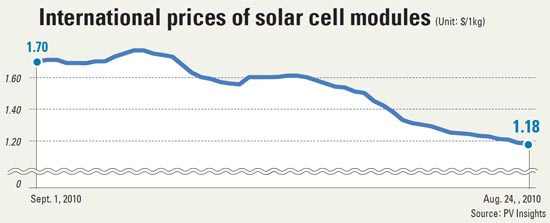Solar industry is in tough times

As the third-biggest solar energy manufacturer in the U.S., the Fremont, California-based company was described as “leading the way toward a brighter and more prosperous future” by U.S. President Barack Obama in May 2010.
But Solyndra’s success story unraveled at light speed a scant year and three months later, as the company abruptly declared bankruptcy last Wednesday.
The downfall of Solyndra, once christened “one of the world’s 50 most innovative companies” by MIT’s Technology Review magazine, follows two other bankruptcy announcements by U.S. solar energy companies during the last month alone, and illustrates the dire business conditions faced by all solar cell manufacturers outside of China - including Korean companies.
According to Solar & Energy, a local market researcher, most solar cell and module manufacturers with production facilities based in Korea suffered operating losses during the second quarter of this year.
Shinsung Solar Energy saw its revenue shrink from $75.3 million in the first quarter to $42.9 million in the second, and an operating profit of $4.1 million in the first quarter turned to operating losses of $3.1 million in the second.
S-Energy also saw is revenue shrink from $54.9 million to $38.4 million and operating profits of $2.9 million turn to losses of $1.9 million, while STX Solar saw operating losses of $1.1 million during the second quarter.
Hyundai Heavy, which has the biggest solar product manufacturing capabilities in Korea, announced a goal of 1 trillion won ($936 million) in revenue with its green energy business in 2011 - consisting of both wind and solar energy projects - surpassing the 550 billion won in revenue it earned from the business last year. However, its green energy revenues from the first half of the year only amounted to 226 billion won, with analysts pointing to the lagging solar energy business as the main reason.
“Basically, everybody’s losing money except makers of polysilicon,” said Baek Young-chan, analyst at Hyundai Securities. Polysilicon, a material consisting of multiple small silicon crystals, is a key component of solar panel construction.
After the news of Solyndra’s bankruptcy hit, stock prices of solar module manufacturers suffered, with S-Energy dropping 7.52 percent from last Friday’s close to end at 8,120 won yesterday, while Shinsung dropped 6.67 percent to close at 4,760 won.
Although observers had touted the solar energy industry’s future in the wave of antinuclear sentiment after the Fukushima nuclear disaster, experts say solar panel manufacturers in Korea and the U.S. haven’t seen any benefits because of two factors: overwhelming competition from cheap Chinese products and shrinking demand due to European economic problems.
“A few years ago, Korean and Japanese companies were jostling for the top spot in solar panel manufacturing. Now it’s all Chinese companies,” said Baek. In fact, Chinese solar panels, which had almost 0 percent market share in the world’s solar energy market in 2005, held about 40 percent of the world’s market share in 2010.
This is because Chinese competitors have been enabled by steady government incentives and cheaper labor to flood the market with very cheap products, analysts say.
In fact, China’s energy regulator announced the first nationwide feed-in tariff (FIT) incentive program for solar power developers last month, and the nation has plans to expand its domestic solar energy market by 2.5 to 4 gigawatts this year and add 5 gigawatts every year for the next decade.
FIT refers to paying a premium rate for electricity from solar power or wind energy to encourage renewable energy production.
Moreover, demand for solar energy products faltered throughout this year as European countries - the primary consumer of solar panels, making up roughly 70 percent of global demand - scaled back spending on renewable energy.
By Lee Jung-yoon [joyce@joongang.co.kr]










with the Korea JoongAng Daily
To write comments, please log in to one of the accounts.
Standards Board Policy (0/250자)